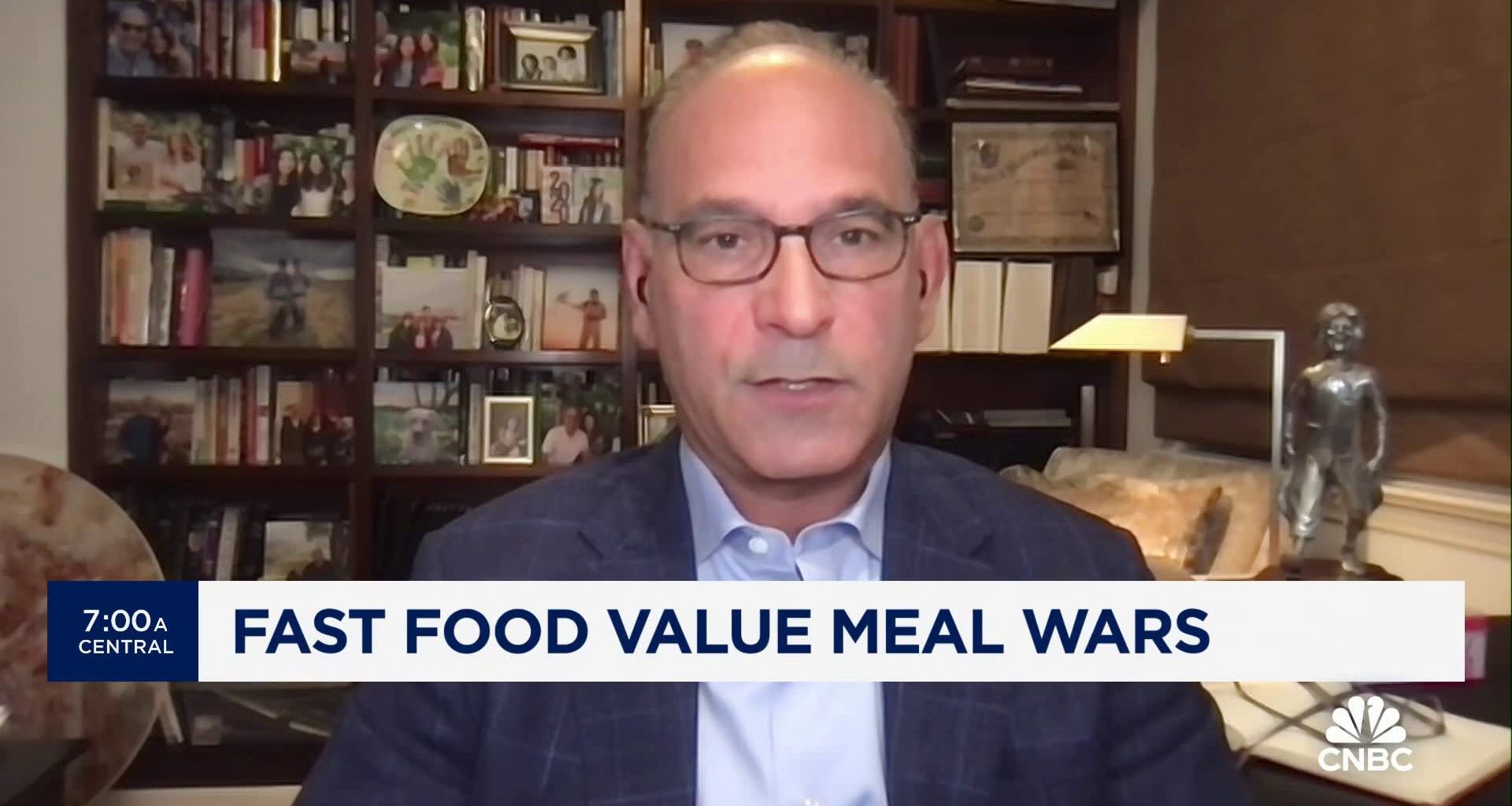A customer views a digital menu at the drive-thru outside a McDonald’s restaurant in Peru, Illinois.
Daniel Acker | Bloomberg | Getty Images
Fast-food restaurants are caving to consumers’ inflation-weary wallets by returning value pricing to their menus — for a limited time. McDonald’s is offering a $5 value menu this month. Wendy’s is rolling out a $3 breakfast. Burger King is adding value deals that it says will be offered “for several months.”
There is a reason the value meals are only returning on a limited basis, says Shubhranshu Singh, associate professor of marketing at the Johns Hopkins Carey Business School, who has studied the economics of fast-food value meals. In a world where ownership also has been hit hard by inflation, it’s at best an “at cost” offer, and at worst, a money loser.
“That $5 meal is not an item that can be a permanent part of the menu; the cost has gone up so much that if franchisees are going to sell $5 value meals, they will lose money on every customer that buys them,” Singh said.
Indeed, while a national association of McDonald’s franchisees cheered the news, it said corporate needs to invest more to make it a permanent part of the menu.
At McDonald’s, options include a McChicken or McDouble, four-piece chicken nuggets, fries, and a drink. Wendy’s deal consists of a bacon or sausage, egg, Swiss cheese, and croissant sandwich, along with a small order of crispy seasoned potatoes (drink not included). Burger King is offering one of three sandwiches or nuggets, plus fries and a drink.
What all the restaurants need is diners adding more to the orders.
“They want customers to get the value meal and then buy more, the idea isn’t that the consumer will buy a value meal and walk away,” Singh said. “If consumers do that, selling that value meal will be such a bad idea.”
In major markets like California, where the minimum wage for fast-food workers is now $20 — and inflationary pressures on ingredients and packaging persist — the only hope restaurants have of turning a profit on a value meal is if a customer buys the meal and also adds an apple pie or other items that have higher margins.
“How can they serve $5 value meals with that minimum wage and still make a profit? It’s impossible any more unless consumers buy other things,” Singh said.
Scott Rodrick, who owns 18 McDonald’s in Northern California, recently told CNBC it’s been “quite a rollercoaster” since the new minimum wage went into effect on April 1. “The impact of this inflation on the customer is the most clear and present concern I have as a franchisee today,” he said. “It has impacted margins.”
Margins are smaller for franchisees to begin with because of royalties that are paid monthly to corporate headquarters, often in the range of four to five percent.
A ‘break-even’ menu proposition, with free sauce thrown into the bargain
To Nick Snowberger, who owns 16 McDonald’s restaurants in Montana and Wyoming, says focusing only on a particular menu price misses the point.
“I focus on holistic value, the total experience: the hospitality, the speed, the accuracy, the cleanliness of the restaurant,” said Snowberger, who noted that over 95% of McDonald’s franchisee’s voted in favor of the $5 bundle.
The value meals are pretty much a break-even proposition when it comes to profit, Snowberger said, but it’s good for the customer. “This is an opportunity to do business at a cost to our customers that is as competitive and incentivizing as we have had in a long time.”
He is trying to throw a lifeline to customers in other ways too, using the latitude and independence he has as a franchise owner.
“We made a decision that we will no longer charge for extra sauces, we will give that to you free. If an order is wrong, we will make it right on us, and we will accept all coupons and accept competitors coupons,” Snowberger said. These are his locally tailored decisions, along with supporting high school athletics, local fairs, and booster clubs.
The price of doing business has “gone through the roof,” he said, with everything from meat, lettuce, fuel, the labor, condiments and wages going up. But he added, “We are not upset about the value menu, but I don’t speak for those that have higher cost pressures than I do.”
McDonald’s corporate declined to comment on the impact of value meals on franchisees profits.

Franchisee focus on Frozen Coke, fatter margin menu items
Shoukat Dhanani, CEO of the Houston-based Dhanani Group, which owns and operates 510 Burger King restaurants across eight states, says value meals are not a losing proposition, even for franchisees.
“We make less margin than we normally make. But we don’t lose money,” Dhanani said. “They are coming in less; we want people to come in more; everyone is feeling the traffic slow down,” he said.
His company also operates 170 Popeyes restaurants, but says the chicken chains haven’t yet felt the price pressure to add a value meal.
Burger King franchisees, similar to McDonald’s, get to vote on new product concepts. “When any promotions come up like this, we vote on that; if it passes, we roll it out. We have some say,” Dhanani said.
Despite the price pressures the consumer is feeling right now, Dhanani says the situation was worse for fast-food restaurants in 2022, when inflation’s squeeze hit them hardest, from labor pressure to commodity prices. The consumer is the one hitting their breaking point now, he said.
“Because of inflation, wages, and insurance going up, we have to raise our prices accordingly to stay in business. When we pass it on, a lot of consumers get a sticker shock,” Dhanani said.
He expects the value menu to be a hit, even though the margins are smaller. Dessert drinks like Burger King’s Frozen Coke and Frozen Strawberry Lemonade have the highest profit margins.
At McDonald’s, franchisees have experience in recent years with the sale of meal bundles, often for $4 or less. “We try to stay as much of a value proposition as we can,” Snowberger said. “But I also can tell you with 100 percent confidence that when you come in, I want to try to sell you more. We are always hoping to sell addition items, pies, cookies, shakes, or bacon on your burger.”
Loss leader ‘mistake’ vs. market share gain
The major fast-food chains aren’t the only quick-service restaurants trying to placate tapped-out customers while keeping franchise operators happy.
Craig Dunaway, chief operating officer of Penn Station East Coast Subs, which operates 320 restaurants in 15 states, says the value concept tried by larger rivals is a loss leader and generally a bad business idea.
“As a franchisor, what we are selling is return on investment. If your franchisee isn’t going to make money, they won’t grow, so introducing loss leaders is a mistake for franchisors,” he said. Only one Penn Station East Coast Subs location is corporate-owned; the rest are franchises.
Value menus are a way to draw in consumers and hope they change their minds, but Penn Station allows franchisees to set their pricing, while corporate sets suggested price points and doesn’t dip into loss-leader territory.
“If Penn Station tried the price point game, we’d lose,” Dunaway said, noting that the chain is absorbing some of the higher costs rather than continually raising prices. At the same time, it is trying to develop new cost-competitive products, like a $4.99 half sandwich on a 9-grain bread being tested this summer.
But Rodrick says there is another way to win with value: increasing market share at a time of declining traffic. He said recent data shows fewer customers in restaurants, and those that do come in are spending less than they were spending before. “The competitive space is getting extraordinarily heated up and we plan to be at the forefront of bringing some relief to the inflation-impacted customer. … Sometimes as franchisee like myself, you’ve got to invest in margin,” Rodrick said.
While franchisees on a local basis have done a good job on value campaigns in their markets, he added that the “national value communication” from McDonald’s “has gotten away from us of late.”
Even though Rodrick described the profit pressure his business is facing in California as “extraordinary” — in addition to wages, it includes a massive increase in insurance costs in the state — “I can just lament the impact or get aggressive about growing market share,” he told CNBC.
No matter how much a franchisee may sacrifice in margins, the value meals do draw in customers.
Randi Maerz, a nurse in Keokuk, Iowa, skipped McDonald’s breakfast burrito recently and was lured to Wendy’s instead to try out the $3 breakfast menu.
“I didn’t want to pay $5 for two burritos at McDonald’s, and one just isn’t very filling,” she said.

Read More: World News | Entertainment News | Celeb News
CNBC








